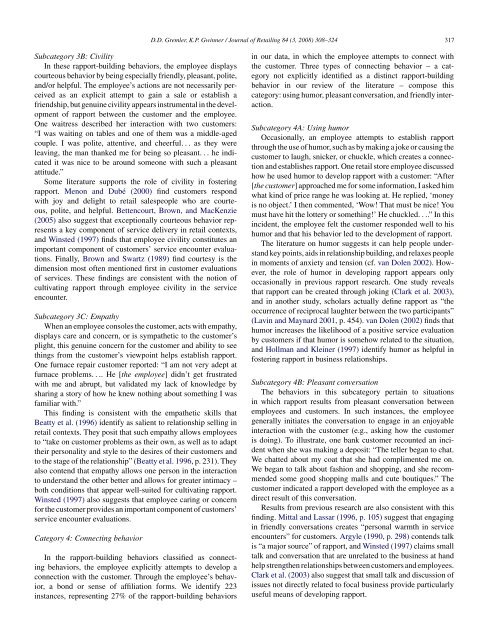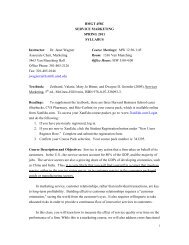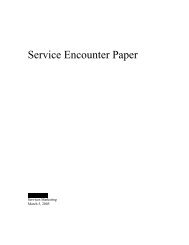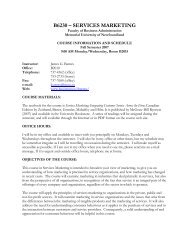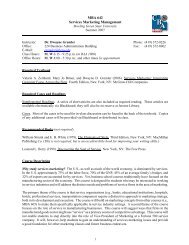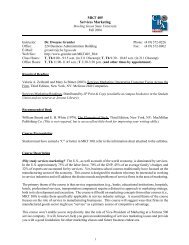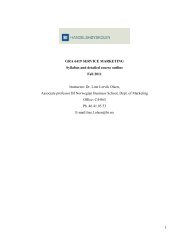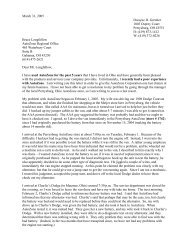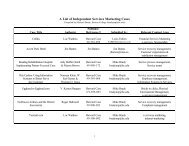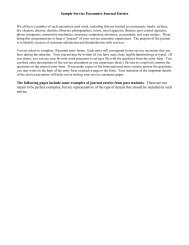Rapport-Building Behaviors Used by Retail Employees - Gremler.net
Rapport-Building Behaviors Used by Retail Employees - Gremler.net
Rapport-Building Behaviors Used by Retail Employees - Gremler.net
Create successful ePaper yourself
Turn your PDF publications into a flip-book with our unique Google optimized e-Paper software.
D.D. <strong>Gremler</strong>, K.P. Gwinner / Journal of <strong>Retail</strong>ing 84 (3, 2008) 308–324 317Subcategory 3B: CivilityIn these rapport-building behaviors, the employee displayscourteous behavior <strong>by</strong> being especially friendly, pleasant, polite,and/or helpful. The employee’s actions are not necessarily perceivedas an explicit attempt to gain a sale or establish afriendship, but genuine civility appears instrumental in the developmentof rapport between the customer and the employee.One waitress described her interaction with two customers:“I was waiting on tables and one of them was a middle-agedcouple. I was polite, attentive, and cheerful... as they wereleaving, the man thanked me for being so pleasant... he indicatedit was nice to be around someone with such a pleasantattitude.”Some literature supports the role of civility in fosteringrapport. Menon and Dubé (2000) find customers respondwith joy and delight to retail salespeople who are courteous,polite, and helpful. Bettencourt, Brown, and MacKenzie(2005) also suggest that exceptionally courteous behavior representsa key component of service delivery in retail contexts,and Winsted (1997) finds that employee civility constitutes animportant component of customers’ service encounter evaluations.Finally, Brown and Swartz (1989) find courtesy is thedimension most often mentioned first in customer evaluationsof services. These findings are consistent with the notion ofcultivating rapport through employee civility in the serviceencounter.Subcategory 3C: EmpathyWhen an employee consoles the customer, acts with empathy,displays care and concern, or is sympathetic to the customer’splight, this genuine concern for the customer and ability to seethings from the customer’s viewpoint helps establish rapport.One furnace repair customer reported: “I am not very adept atfurnace problems....He[the employee] didn’t get frustratedwith me and abrupt, but validated my lack of knowledge <strong>by</strong>sharing a story of how he knew nothing about something I wasfamiliar with.”This finding is consistent with the empathetic skills thatBeatty et al. (1996) identify as salient to relationship selling inretail contexts. They posit that such empathy allows employeesto “take on customer problems as their own, as well as to adapttheir personality and style to the desires of their customers andto the stage of the relationship” (Beatty et al. 1996, p. 231). Theyalso contend that empathy allows one person in the interactionto understand the other better and allows for greater intimacy –both conditions that appear well-suited for cultivating rapport.Winsted (1997) also suggests that employee caring or concernfor the customer provides an important component of customers’service encounter evaluations.Category 4: Connecting behaviorIn the rapport-building behaviors classified as connectingbehaviors, the employee explicitly attempts to develop aconnection with the customer. Through the employee’s behavior,a bond or sense of affiliation forms. We identify 223instances, representing 27% of the rapport-building behaviorsin our data, in which the employee attempts to connect withthe customer. Three types of connecting behavior – a categorynot explicitly identified as a distinct rapport-buildingbehavior in our review of the literature – compose thiscategory: using humor, pleasant conversation, and friendly interaction.Subcategory 4A: Using humorOccasionally, an employee attempts to establish rapportthrough the use of humor, such as <strong>by</strong> making a joke or causing thecustomer to laugh, snicker, or chuckle, which creates a connectionand establishes rapport. One retail store employee discussedhow he used humor to develop rapport with a customer: “After[the customer] approached me for some information, I asked himwhat kind of price range he was looking at. He replied, ‘moneyis no object.’ I then commented, ‘Wow! That must be nice! Youmust have hit the lottery or something!’ He chuckled....” In thisincident, the employee felt the customer responded well to hishumor and that his behavior led to the development of rapport.The literature on humor suggests it can help people understandkey points, aids in relationship building, and relaxes peoplein moments of anxiety and tension (cf. van Dolen 2002). However,the role of humor in developing rapport appears onlyoccasionally in previous rapport research. One study revealsthat rapport can be created through joking (Clark et al. 2003),and in another study, scholars actually define rapport as “theoccurrence of reciprocal laughter between the two participants”(Lavin and Maynard 2001, p. 454). van Dolen (2002) finds thathumor increases the likelihood of a positive service evaluation<strong>by</strong> customers if that humor is somehow related to the situation,and Hollman and Kleiner (1997) identify humor as helpful infostering rapport in business relationships.Subcategory 4B: Pleasant conversationThe behaviors in this subcategory pertain to situationsin which rapport results from pleasant conversation betweenemployees and customers. In such instances, the employeegenerally initiates the conversation to engage in an enjoyableinteraction with the customer (e.g., asking how the customeris doing). To illustrate, one bank customer recounted an incidentwhen she was making a deposit: “The teller began to chat.We chatted about my coat that she had complimented me on.We began to talk about fashion and shopping, and she recommendedsome good shopping malls and cute boutiques.” Thecustomer indicated a rapport developed with the employee as adirect result of this conversation.Results from previous research are also consistent with thisfinding. Mittal and Lassar (1996, p. 105) suggest that engagingin friendly conversations creates “personal warmth in serviceencounters” for customers. Argyle (1990, p. 298) contends talkis “a major source” of rapport, and Winsted (1997) claims smalltalk and conversation that are unrelated to the business at handhelp strengthen relationships between customers and employees.Clark et al. (2003) also suggest that small talk and discussion ofissues not directly related to focal business provide particularlyuseful means of developing rapport.


